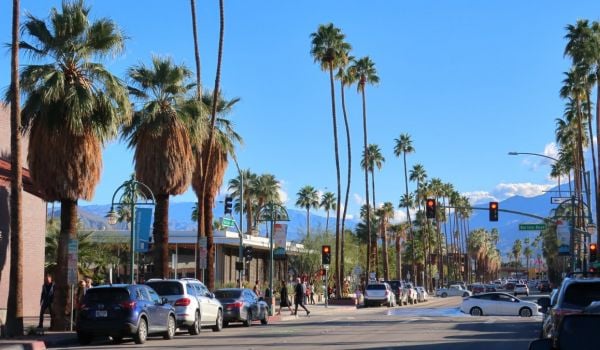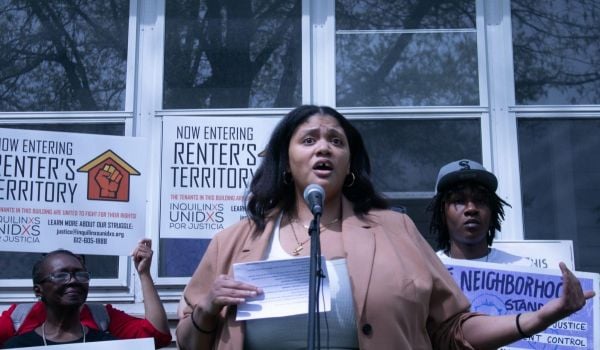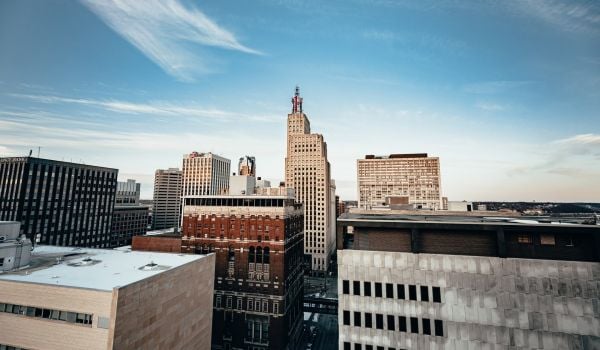As the U.S. faced challenges to our democracy and a worldwide pandemic, neighborhood organizers, mayors and racial justice advocates — our Next City community — proved that true problem-solvers never relent. Here are some of their share-worthy ideas, which we’ll continue to report on in the coming year.
1. Tenant-landlord Mediation
With the pandemic-sparked economic downturn, untold numbers of renters in the U.S. became newly vulnerable to financial and housing insecurity. Advocates worry that a wave of evictions will follow the lifting of emergency moratoriums currently in place. But pre-court mediation programs in Philadelphia offer an approach to preventing displacement and heading off protracted legal battles between landlords and tenants.
As part of the Philadelphia Eviction Prevention Project, the Good Shepherd Mediation Program has tested free and voluntary landlord-tenant mediation — and, during COVID19, has started offering a virtual mediation through Zoom.
“Mediation is a particularly good conflict-resolution process for situations where the parties have some kind of a relationship and they’re going to continue to have some kind of a relationship, as opposed to a car accident with a stranger, where you don’t know the person,” says Sue Wasserkrug, a program administrator.
Mediators act as neutral third parties, and their goal is to help clients — including landlords and tenants — identify and talk through problems they’re having, Wasserkrug says. And they help parties talk through grievances on both sides, whether that’s about needed repairs or trouble with paying rent.
Ideally, the mediation leads to some type of plan that both parties can agree to, Wasserkrug says, but often, it pays off even before that, just by helping the parties communicate better.
“It’s free. It’s way less stressful and more convenient [than court]. It causes a lot less disruption in people’s lives. It can eliminate the need for landlords’ units to go empty and for the possibility that tenants might become homeless,” she says.
The city of Philadelphia could expand the Good Shepherd pilot program, using money from the city’s Housing Trust Fund. Meanwhile, the city’s Fair Housing Commission (FHC) is also starting to offer mediation for landlords and tenants prior to Commission hearings.
“Mediation by a neutral third party, especially pre-court mediation, helps to balance that power dynamic,” says Rue Landau, executive director of the Philadelphia Commission on Human Relations and FHC. “When done right, you’re making sure that the tenant is not giving up any of their legal rights, and that landlords are protected as well.” — Jared Brey
This is an excerpt from a Next City article published as “Helping Tenants and Landlords Resolve Issues — Before Going to Court” on May 19, 2020.
2. Democratizing Homeownership
COVID-19 presents an opportunity for foundations and impact investors — investors that prioritize social or environmental returns, not just financial returns — to fund real estate models that democratize ownership and governance to build community wealth.
Foundations could provide capacity-building grants as well as patient mission-related investment to serve as equity injections into community-owned deals. Models such as land trusts, for example, are more likely to provide longterm affordability — although they don’t always provide direct wealth-building opportunities. Limited-equity housing co-ops and emerging models like Neighborhood Real Estate Investment Trusts and Community Investment Trusts offer residents who would otherwise be displaced by revitalization, an opportunity to build wealth through it instead.
In Portland, Oregon, Mercy Corps created the Community Investment Trust, a model that enables historically disenfranchised and economically marginalized residents to invest and build equity via shared ownership in commercial real estate. The trust was created using philanthropic capital from Mercy Corps as well as patient equity from an impact investor to create a financial product for community ownership of a retail strip mall for residents in the neighborhood. Residents receive financial and investment training, and invest as little as $10 to $100 per month buying shares and paying back the down payment on the property, which had been provided by Mercy Corps and the impact investors. The resident investors, who are mostly renters, women, people of color, and refugees and immigrants, receive dividends annually, and long-term share price appreciation based on the mortgage reduction and change in the property’s value. Their investment is protected from loss through a letter of credit from the bank that provided the mortgage, which also allows investors to exit any time. In 28 months since launch, the trust has delivered three rounds of dividends averaging 9.3 percent to 140 families to-date, and a share price gain from $10/share to $15.86/ share. For low-income investors that don’t get access to traditional investment opportunities, this is significant.
For foundations and impact investors working on closing the racial wealth gap, models like the CIT create not only a wealth-building opportunity for low-income people of color, but also catalyze democratic participation at a meaningful scale by offering access to place-based ownership. — Nikishka Iyengar and John Haines
This is an excerpt from a Next City op-ed published as “Preparing for the Post-COVID-19 Land Grab” on June 3, 2020.
3. Erasing the Digital Divide
A lack of internet access is a “public health concern,” Apoorva Pasricha, Harvard Business School Fellow for the city of San Jose, and Kevin Frazier, head of No One Left Offline, charged in a September 2020 Next City op-ed. Similar to how lead paint was once designated a hazard to be monitored by housing authorities, they suggest, online access should be on federal, state and local inspection checklists for public and Section 8 housing.
New York City released its Internet Master Plan at the start of 2020 to solve once and for all the problem of nearly a third of households lacking a broadband connection, and over 1.5 million New Yorkers having neither a mobile connection or home broadband connection. As Emily Nonko reported in January’s “New York’s New Broadband Plan Hopes to (Finally) Address the Digital Divide,” the public-private partnership vision calls for a network expansion, with “neutral host” infrastructure that can be shared by multiple operators rather than a single company. At an estimated cost of $2.1 billion, implementing this “universal broadband” plan will require an ambitious unification of stakeholders and substantial public and private investment.
“It’s an opportunity for anyone — large and small, existing players in the broadband market and those who have not been here — to respond with their ideas,” John Paul Farmer, the city’s chief technology officer, told Nonko. “There is no silver bullet, and we don’t anticipate any one organization or company to be the answer. It’s going to be a portfolio approach with everyone at the table with the role they see themselves playing, and asking them what would they need to make that happen.”
4. Voting Rights
With a record number of people casting ballots to decide the 2020 presidential election, voting rights advocates want to build on the momentum. Grassroots movements to expand voter engagement and voter access across the United States — as disenfranchisement is perpetuated at federal and local levels — will hopefully continue to boom well into the next campaign cycle. Many of these efforts are focused on current and formerly incarcerated people, 16- and 17-year-olds, and voters in their 20s who have of late had the lowest rates of turnout.
As James A. Anderson reported for Next City in July, “in several cities around the country, 16- and 17-year-olds are already voting in local elections. A wealth of data supports the wisdom of enfranchising young voters — turnout is high in this age group, and neuroscience suggests their brains are primed for calculated decision-making. Countries that have implemented age-16 voting before now have found that cultivating good civic behaviors early leads to long-term engagement, both for young voters and for those around them.” While a San Francisco proposition to lower the voting age to 16 failed in November, an Oakland measure to allow those as young as 16 to vote in school board elections passed. (Berkeley passed a similar law in 2016.) Anderson spoke with Brandon Klugman, campaign manager for Vote16USA, who said, “We’ve seen a groundswell in the level of attention the issue is getting. That goes along with an increase in youth activism among 15-, 16- and 17-year-olds who are making clear that they not only have a stake in politics, but that they’re equally ready, willing and able to take part in choosing government officials.”
The Midwest Culture Lab is finding ways to get out the vote with Millennials and Gen Z. Cinnamon Janzer reported in October that the coalition of organizers has “tested new forms of messaging that meet youth of color where they are. That means working with a diverse group of artists and coming up with messages that are more interesting and meaningful, such as ‘We All We Got’ and ‘OUT VOTE,’ positioning voting as an act of self-reliance and reframing it as an opportunity to vote out politicians who don’t care about the issues affecting communities of color. It also meant working with local figures with deep followings in the communities of color Midwest Culture Lab’s trying to reach, rather than aiming for a famous celebrity with broader appeal. This means working with DJs, painters, poets and more as well as aspiring artists to help them see the opportunity for activism in their work as well as partnering with them to hold a variety of events — these days, digital — to reach the artists’ dedicated followings and normalize civic participation.”
In July, the Washington, D.C. council passed a bill that extended the right to vote to residents currently incarcerated on felony offenses. While a voter-endorsed amendment in Florida to enfranchise formerly incarcerated people was hampered by that state’s Republican-controlled legislature — and advocates will have to continue to fight to reverse that injustice — Eddi Cabrera Blanco reported in Next City that “D.C. advocates are hopeful that enfranchising incarcerated felons will inspire state governments to do the same. A day after passing the bill, Councilmember Robert White took to Twitter to share the announcement, adding, ‘My hope is that state after state will follow our lead and will restore the vote.’”
5. Reckoning on Race
May 31–June 1, 2021 will mark 100 years since the Tulsa Race Massacre, when mobs of white residents attacked Black residents and burned down businesses of the city’s Greenwood District, also known as Black Wall Street. As Emily Nonko reported in June, work by the 1921 Tulsa Race Massacre Centennial Commission offers some guidance on confronting racist violence in the past and present. The group, she wrote, “has made significant progress on beginning a dialogue not just around the massacre’s history, but ways that Tulsa and the country can learn and heal from it.” Among its many ongoing projects: the development of a curriculum to teach students about Greenwood (with webinars during COVID-19); a history center known as Greenwood Rising expected to open in 2021; and partnerships to support black entrepreneurship.
Project Manager Phil Armstrong told Nonko he is hopeful that the Greenwood District will be ready for a national acknowledgment and commemoration of the Tulsa Race Massacre. “Tulsa will become a place for unity, reconciliation and healing,” he said. “We can use this tragedy to bring people together.”
6. Universal Basic Income
For a growing cadre of mayors across the country, the COVID-19 pandemic has exposed more than just the stubborn racial inequity built into the U.S. economy. It has also exposed what’s possible in a modern-day economy — universal basic income.
“We don’t have a funding problem, we have a priorities problem,” said St. Paul Mayor Melvin Carter, in a September press briefing. “This is a concept, frankly, that is far more controversial in halls of government than on any street in America.”
The press briefing, organized by Mayors for a Guaranteed Income, featured more than a dozen other mayors from across the country. The coalition started with 11 members in June 2020, and at the briefing, the coalition announced 14 new members. These mayors have all committed to funding or exploring basic income pilots in their cities — as a hopeful first step toward a federal universal basic income program.
Proposed in various forms for decades — including by Martin Luther King Jr. — and recently popularized by presidential candidate Andrew Yang (who called it a “Freedom Dividend”), universal basic income is exactly what it sounds like: direct cash assistance for everyone.
A recent poll by The Hill found a majority of voters now supports a universal basic income, up 12 percentage points from just one year earlier.
But the mayors on the press briefing universally recognized the uphill battle they face convincing policymakers in Washington, D.C., that universal basic income is the way to go. They see a need to fight back against the old racist tropes like “welfare queens” spending government money on junk food and drugs, stereotypes created to justify severe cuts to social safety net programs in the past. And of course there are persistent questions about how to pay for a nationwide, universal basic income program.
“Guaranteed income has to be a federal solution,” said former Stockton Mayor Michael Tubbs. “But we understand Washington can’t move as fast. We need to give folks in D.C. the stories and the cover to do this.”
Some basic income pilot programs in U.S. cities have been funded entirely with private philanthropic dollars, like the HudsonUP program in Hudson, New York. It is providing $500 each month for 5 years to just 25 recipients living within city limits and earning up to the median income for Hudson, $35,153. Chosen at random, participants may be single or married, with children or not. The lottery is weighted by equity and overseen by independent researchers at the University of Pennsylvania and the University of Tennessee Knoxville.
Others are combining public dollars with private dollars. St. Paul’s $1.5 million program will be mainly funded from private philanthropy, with $300,000 coming from the city’s allocation of CARES Act funding.
At the September press conference, Tubbs reiterated that the group’s collective end vision is for universal basic income, federally funded. The idea with the smaller pilots is to generate quantitative and qualitative data to convince federal policymakers.
The group also sees a wide range of knock-on effects to their communities. Mayor Shawyn Patterson-Howard of Mount Vernon, New York, touted the boost for small businesses in her community that would come from universal basic income. “When you give money to big businesses, they invest in offshore accounts,” said Mayor Patterson-Howard. “When you give money to people, they’re going to spend it in their community.”
On the question of how to fund a universal basic income program, the COVID-19 pandemic has emboldened the group. There’s the evidence that the initial round of $1,200 economic impact payments helped keep 10 million families from falling into poverty. But even more emboldening has been the massive amount of aid and low-interest lending that the federal government has made available to large corporations in the wake of the pandemic. “These people are printing money, so the idea is the money is there, but the will is not there,” said Newark Mayor Ras Baraka. “They’re finding money somewhere, giving it out, and arguing about who gets it. We’re saying this is where it needs to go, and we want them to understand it needs to be in perpetuity, not just a one-off thing.” — Oscar Perry Abello
This is an excerpt from a Next City article published as “These Mayors Say This Is Universal Basic Income’s Moment” on September 24, 2020.








_600_350_80_s_c1.jpg)







